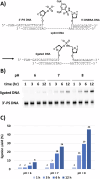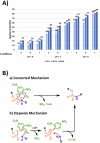Chemical autoligation with phosphorothioate- and sulfonamide-terminated DNA via intramolecular cross-activation
- PMID: 40770541
- PMCID: PMC12328621
- DOI: 10.1038/s42004-025-01631-x
Chemical autoligation with phosphorothioate- and sulfonamide-terminated DNA via intramolecular cross-activation
Abstract
Chemical ligation of oligonucleotides enables assembly of long DNA constructs essential for genome engineering, DNA nanotechnology, and molecular diagnostics, but current methods often require external activators and suffer from reactive intermediate instability. Here we show a reagent-free DNA autoligation strategy based on intramolecular cross-activation between 3'-phosphorothioate (PS) and 5'-dinitrobenzenesulfonamide (DNBSA) termini on a splint DNA, yielding a P3' → N5' phosphoramidate linkage under near-physiological conditions. Ligation proceeds with over 80% yield at 37 °C and pH 8 without external reagents. The DNBSA group exhibits exceptional aqueous stability, and in situ formation of reactive intermediates contributes to high efficiency. This strategy expands the current toolkit for assembling DNA constructs and may facilitate future biotechnological and therapeutic studies.
© 2025. The Author(s).
Conflict of interest statement
Competing interests: The authors declare no competing interests.
Figures





Similar articles
-
Surgery for Dupuytren's contracture of the fingers.Cochrane Database Syst Rev. 2015 Dec 9;2015(12):CD010143. doi: 10.1002/14651858.CD010143.pub2. Cochrane Database Syst Rev. 2015. PMID: 26648251 Free PMC article.
-
Interventions for interpersonal communication about end of life care between health practitioners and affected people.Cochrane Database Syst Rev. 2022 Jul 8;7(7):CD013116. doi: 10.1002/14651858.CD013116.pub2. Cochrane Database Syst Rev. 2022. PMID: 35802350 Free PMC article.
-
Occlusal interventions for managing temporomandibular disorders.Cochrane Database Syst Rev. 2024 Sep 16;9(9):CD012850. doi: 10.1002/14651858.CD012850.pub2. Cochrane Database Syst Rev. 2024. PMID: 39282765
-
Restrictive versus liberal red blood cell transfusion strategies for people with haematological malignancies treated with intensive chemotherapy or radiotherapy, or both, with or without haematopoietic stem cell support.Cochrane Database Syst Rev. 2024 May 23;5(5):CD011305. doi: 10.1002/14651858.CD011305.pub3. Cochrane Database Syst Rev. 2024. PMID: 38780066 Free PMC article.
-
Home treatment for mental health problems: a systematic review.Health Technol Assess. 2001;5(15):1-139. doi: 10.3310/hta5150. Health Technol Assess. 2001. PMID: 11532236
References
-
- Li, X. & Liu, D. R. DNA-templated organic synthesis: nature’s strategy for controlling chemical reactivity applied to synthetic molecules. Angew. Chem. Int. Ed.43, 4848–4870 (2004). - PubMed
-
- Percivalle, C., Bartolo, J.-F. & Ladame, S. Oligonucleotide-templated chemical reactions: pushing the boundaries of a nature-inspired process. Org. Biomol. Chem.11, 16–26 (2013). - PubMed
-
- Gorska, K. & Winssinger, N. Reactions templated by nucleic acids: more ways to translate oligonucleotide-based instructions into emerging function. Angew. Chem. Int. Ed.52, 6820–6843 (2013). - PubMed
-
- Kukwikila, M., Gale, N., El-Sagheer, A. H., Brown, T. & Tavassoli, A. Assembly of a biocompatible triazole-linked gene by one-pot click-DNA ligation. Nat. Chem.9, 1089–1098 (2017). - PubMed
LinkOut - more resources
Full Text Sources

